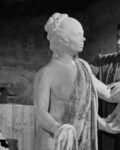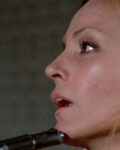Film: What Have They Done to Your Daughters? / The Coed Murders / La polizia chiede aiuto (1974)
 Film: Very Good
Film: Very Good
Transfer: n/a
Extras: n/a
Label: n/a
Region: n/a
Released: n/a
Genre: Giallo / Poliziotteschi
Synopsis: A dogged detective and a newly minted District Attorney are determined to smash a teen prostitution ring in Rome, while a lunatic rides around town with a really big meat cleaver.
Special Features: n/a
Review:
Although regarded as the second part in Massimo Dallamano’s schoolgirl-in-peril trilogy, this entry moves farther from the giallo roots in What Have You Done to Solange? (1972), emphasizing elements of the poliziotteschi genre in which corruption runs deep, victims and their families rarely achieve any justice, and the serial killer’s motivation isn’t rooted in some childhood trauma nor elaborate revenge scheme.
Daughters is ostensibly a tale of high level corruption tied to a prostitution racket that’s unearthed when the body of a pregnant teen is found hanging in a love pad somewhere in Rome. The serial killer subplot involves a helmeted motorcyclist who cleavers big mouths to death so the racket can continue to service its judges, businessmen, and well-placed perverts.
The sleaze factor is ramped up in this ‘thematic sequel’ with often grotesque glee, making the bookend filmmaker captions about the evils of prostitution rather ridiculous: this is total trash that runs at 60 mph.
As the first film created shocks by revealing cadavers with hideous genital impalements, Daughters revels in its opening scenes by showing the dead teen, suspended naked from a rafter, from ridiculous angles; sure, the police have to navigate around the body to gather clues, but there’s no reason to frame banal procedural dialogue by emphasizing the dead teens pale bare breasts. The imagery is furthered when the District Attorney details the release of a photo to help identify the teen, but only after meeting with the lead detective does she express disdain for the press using a full-body shot of the teen’s nude cadaver.
It’s a schizophrenic stance the filmmakers use to place the grotesque up front, and then have characters make a meager editorial comment akin to ‘This is just horrible!’ but unlike the blunt encounters between investigators and victim families in Solange, there’s a heavier grimness to Dallamano’s story (co-written with Ettore Sanzo). Needing a moral auger, that clever ingredient comes in the form of Assistant D.A. Stori (Giovanna Ralli), a headstrong woman determined to bring justice on her first case for the state.
As the dead girl’s father, Polvesi, American actor Farley Granger (in his final giallo, after So Sweet, So Dead and Savage City) has little to do except be confused and outraged, but the scenes between the mother (Marina Berti) and Stori are often quite affecting, due in large part to the strong casting, and the actresses underplaying their roles; whereas the mothers in Solange were hysterical and incapable of confronting horrible details compared to their husbands, a measured Mrs. Polvesi is constantly processing details of the memories we’re shown in flashbacks that may hold clues to her shift from a loyal teen to a calmly rebellious daughter.
Mario Adorf (The Bird with the Crystal Plumage, Short Night of Glass Dolls) has a small role as an inspector whom we know will discover his own daughter is part of the racket – a squirm-inducing scene in which the detectives listen to audio recordings of raped teens clinches the proof – but the lead investigator is Silvestri (Claudio Cassinelli, a dead-ringer for American actor Thomas Jane) always defers to D.A. Stori; even when he flies off the handle, frustrated by the layers of lies, omissions, and useless clues from suspects and witnesses, he recognizes and accepts Stori’s authority.
Where the plotting starts to thin out isn’t in the superbly choreographed and edited chase scenes but the pretty nonsensical serial killer subplot: opening carrying a cleaver, the butcher literally stalks and attacks victims in full motorcycle regalia, even at night or in a dark parking garage. He’s also able to enter a hospital at attempt another kill while helmeted, and never loses his way in spite of having to see through a darkly tinted visor.
Dallamano’s inherent lack of sensitivity (or maybe perverse sense of humour) comes to a head in a scene where the bitchy ex-wife of a missing philanderer must identify the body of her husband, found hacked to pieces in a car trunk. The coroner emphasizes she need only see his face for a formal identification, but she insists on seeing the sonofabitch, so in a grisly moment of ‘Well, you asked for it!’ the sheets are pulled back to reveal the horrific trauma. (The state of the body isn’t a shock to us at this stage because Dallamano kindly crafted a sequence where the body’s reassembled, beginning with a log angle of the cleaved torso and the man’s dangling penis.)
The body’s identification also marks the midpoint when clues are gradually assembled, witnesses are found, and small details reveal the despicable cover-up. The natural conclusion has to involve some fast physical motion to give the talky scenes momentum, and that comes in the form of a stellar car chase in which the killer evades a huge team of police; and the finale in which the killer is corned and finally dispatched to hell. Dallamano makes excellent use of real locations – there’s a sense few sets were created for the film – and many of the chases and finale are packed with street extras, adding to the film’s slick docu-drama look.
The cinematography by Franco Dello Colli (Innocence and Desire, Strip Nude for Your Killer) features beautifully composed ‘scope images and taut handheld camerawork, especially in hallway and stairwell chases, and Solange’s editor Antonio Siciliano crafted some great montages and a few genuine jumps.
Perhaps the weakest element is Stelvio Cipriani’s score which sometimes echoes Ennio Morricone’s dissonance from Solange, but is dominated by a weirdly bawdy main theme that’s perhaps meant to infer the immorality that lies under slick characters, neatly attired officials, pretty teens, and ornate buildings where the racket has its tentacles. Perhaps. Most of the time the score works, but the fusion of a punchy jazz beat, mocking brass, and an urban groove aren’t as affecting as Morricone’s patented mix of gentle yet unnerving lullaby themes and gnashing dissonance.
While there’s no twist ending – the finale is more typical of a detective thriller than formal giallo – the filmmakers’ bleak worldview certainly resonates when Silvestri is told to be content with having found the killer and leave the racket alone, since going after its high-level clients might put the power and efficacy of many government bodies in jeopardy.
Dallamano would direct and co-write three more films – The Cursed Medallion (1975), Teenage Emanuelle (1976), and Colt .38 Squad (1976) – before being killed in a car accident in 1976, but two scripted projects were completed posthumously: La linea del fiume (1976) and the third and weakest entry in the schoolgirls-in-period trilogy, Virgin Killer (1978).
© 2016 Mark R. Hasan
External References:
Editor’s Blog — IMDB — Soundtrack Album — Composer Filmography
Vendor Search Links:
Amazon.ca
— Amazon.com
— Amazon.co.uk
Category: Blu-ray / DVD Film Review

















Connect